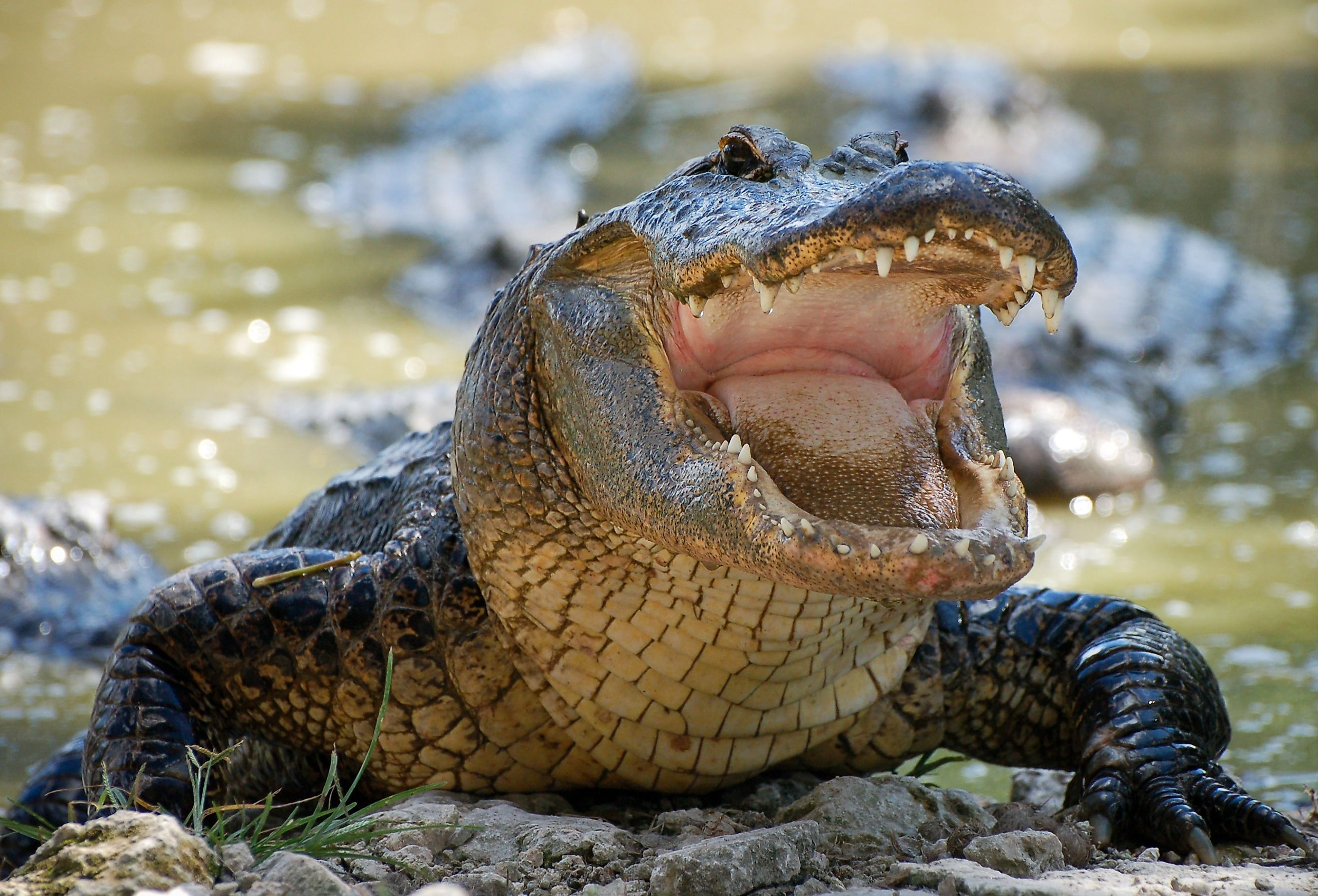
The 11 Deadliest Animals in South Carolina
With its diverse and stunning landscape, South Carolina offers no shortage of outdoor fun, cultural heritage, and community. A nature lovers paradise, South Carolina boasts beaches, mountains, lakes, and rivers. From hiking Glassy Mountain to boating on Lake Keowee to skiing and snowboarding the Appalachian Mountains, the opportunities are endless. Along your journey, you may spot wildlife such as the black bear, red foxes, bobcats, and snakes. However, interacting with this natural beauty does not come without hazards. While enjoying South Carolina, be on the lookout for some of its deadliest animals, such as the Cottonmouth snake, American Alligator, and the dreaded tick.
Eastern Diamondback Rattlesnake
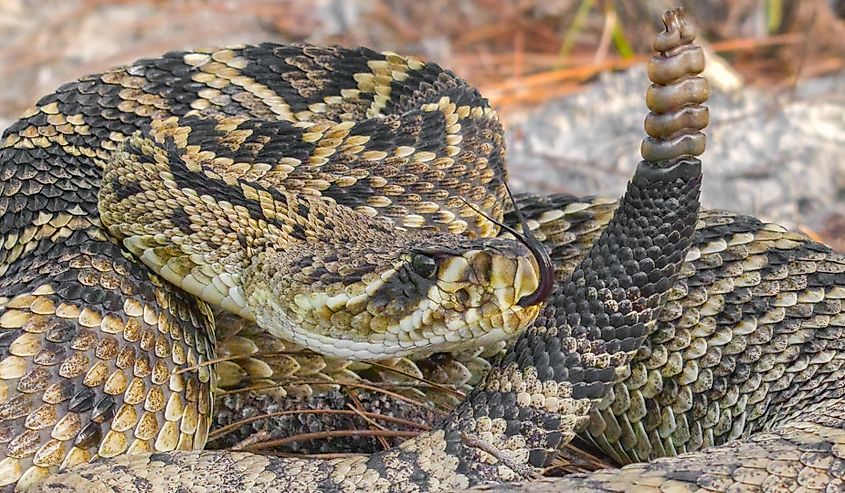
One of nature’s most formidable reptiles, this venomous snake can be found in pine forests, coastal dunes, and dry, sandy areas. The eastern diamondback rattlesnake is the largest venomous snake in North America, known for its potent venom. Generally, this snake is solitary and territorial, active during the day in the cooler months, and nocturnal during the summer.
This snake can be identified by its recognizable diamond-shaped back pattern. These solitary creatures only interact with each other during mating season. The young are independent from birth. With no parental care, they must fend for themselves immediately.
The Eastern Diamondback has a potent hemotoxic venom, a type of venom that can cause internal bleeding, hemorrhage, necrosis, and fibrinolysis. At 3 to 6 feet long, this snake can deliver large quantities of venom in a single bite. Due to its brown color, this snake can be hard to spot, increasing the chances of accidental encounters.
As you are enjoying South Carolina’s outdoors, beware of the Eastern Diamondback’s warning signs of an attack. The most recognizable warning sign is the well-known rattling of its tail. If you hear rattling, move slowly away. Other warning signs include a coiled posture, hissing, and head swaying.
Stay calm if an Eastern Diamondback bites you. Panicking can increase your heart rate, spreading venom faster. Keep the bite below the heart to slow the spread of venom and seek medical help immediately. Do not use a tourniquet or cut the wound. These outdated methods may cause more harm than good.
If you come across this snake do not panic. Instead, give it plenty of space and do not disturb it. Stay informed and appreciate this remarkable creature from afar.
Cottonmouth (Water Moccasin)
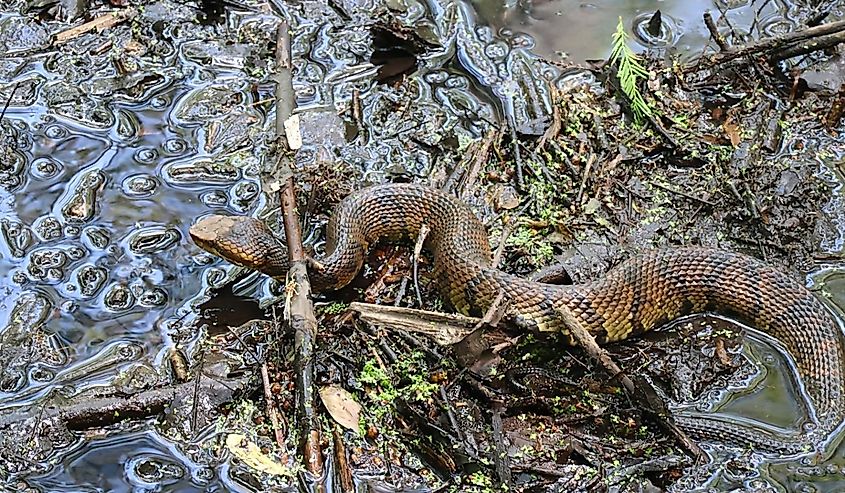
A venomous snake often found near water bodies, the Cottonmouth is a large, thick-bodied snake with a triangular head and keeled scales. It gets its name, Cottonmouth, from the white interior of its mouth, a stark difference from its dark-colored body. Though some can grow longer, this snake typically measures between 2 and 4 feet.
The Cottonmouth is semi-aquatic, thriving in wetlands such as swamps, rivers, lakes, and streams. They prefer slow-moving or still water and can be found basking on logs or banks. These snakes are excellent swimmers and can be seen in the water or on land.
Like most snakes, the Cottonmouth is solitary, except during mating season. They are most active during the warmer months and feed on fish, amphibians, small mammals, and birds.
Containing hemotoxins, Cottonmouth's venom can be very dangerous; its bite fatal if not treated promptly. Its bite can cause swelling, necrosis, breathing difficulties, and shock. These snakes are aggressive and will stand their ground when threatened. Warning signs of an attack include mouth gaping, coiling, tail vibrating, and hissing. If a Cottonmouth opens its mouth wide, displaying its white interior, it may be readying to attack.
If a Cottonmouth snake bites you, keep a level head to slow the spread of venom. Move away slowly and seek medical attention immediately. Do not apply ice. While spotting this creature can be exciting, it is important to respect its power and role in the ecosystem.
Timber Rattlesnake
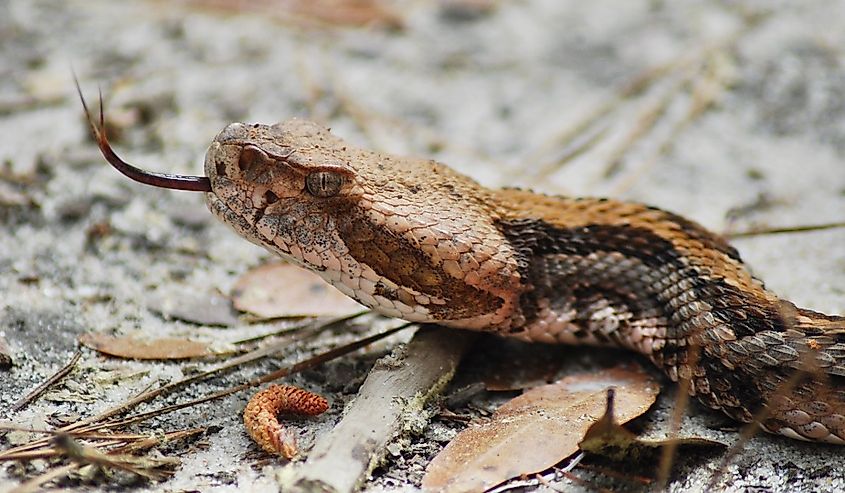
Often misunderstood, these highly venomous rattlesnakes play a crucial role in the ecosystem. They aid in controlling the rodent population and maintain the balance between predator and prey animals. This large snake typically measures between 3 and 5 feet long. Its coloration varies from yellowish-brown to gray or black with dark crossbands along its body.
You will find these snakes in forests, rocky outcrops, and mountainous areas. During the warmer months, they can be seen sunbathing while they hibernate in communal dens during the winter. These communal dens may be with other Timber Rattlesnakes or other snake species. An ambush predator, this snake preys on small mammals and birds.
The Timber Rattlesnake is considered dangerous due to its potent hemotoxin venom. The venom’s effect can be life-threatening if not treated properly and can destroy tissue, disrupt blood clotting, and cause severe pain and swelling. However, death is rare because of the access to antivenom.
If you hear the distinctive rattling sound of their tail, know they feel threatened and are getting ready to strike. Other warning signs are coiled posture, hissing, and defensive, warning strikes. If you are bitten by a Timber Rattlesnake, stay calm and back away slowly. Seek medical attention immediately and do not apply ice or use a tourniquet. Remove any tight or constrictive items like jewelry and tight clothing.
A vital part of the ecosystem, these incredible animals can be dangerous if stumbled upon. If you come across one, appreciate the animal, do not provoke it, and continue to enjoy South Carolina’s outdoors responsibly.
Copperhead Snake
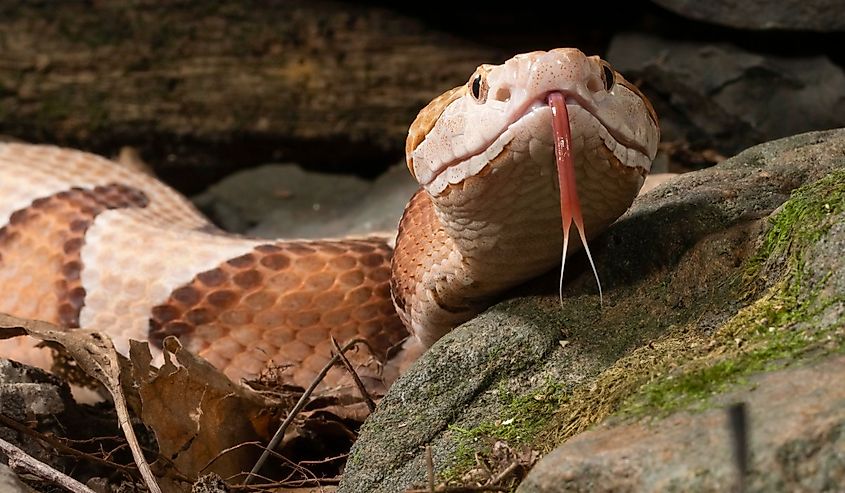
South Carolina is home to six species of venomous snakes, and the Copperhead is another that is common in the state. Its bite is rarely fatal but can cause significant pain and tissue damage. This medium-sized snake can grow between 2 and 3 feet long. It earned its name with its copper-colored head, contrasting to its darker brown body.
Highly adaptable, Copperheads can be found in various habitats from forests and grasslands to swamps and rocky hillsides. These carnivores feast on mice, voles, birds, amphibians, and insects. They rely on their camouflage, hiding and striking unsuspecting prey that passes by.
Like many other snakes, Copperheads are solitary, active from late spring to early fall. When they feel threatened, they will freeze in place, using their camouflage to avoid detection. Other signs they may exhibit when feeling threatened are tail vibration, producing a warning sound in the leaves, and a coiled striking posture.
The Copperhead snake’s venom contains hemotoxins. Though less potent than the other snakes in the state, it can be painful and cause serious medical issues if not treated. If you are bitten by a Copperhead snake stay calm and back away slowly as not to provoke the snake again. Keep the bite below heart level and seek medical attention immediately.
These fascinating snakes are a sight to see. Be aware of your surroundings during your time outdoors and stick to well-traveled paths while appreciating the wildlife.
Black Widow Spider
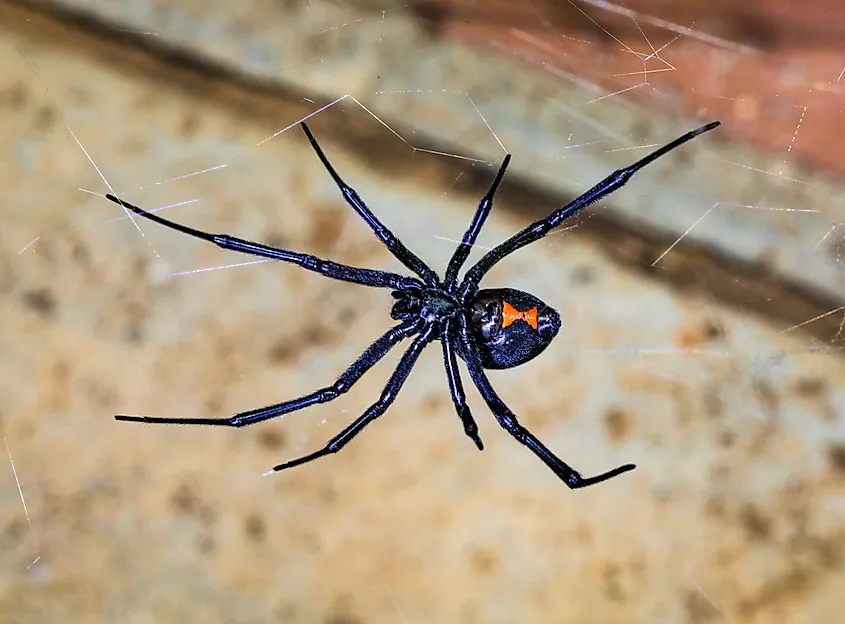
One of the most infamous spiders in South Carolina, this venomous spider is known for its glossy appearance and reclusive nature. Easily recognizable by its glossy black body and red hourglass marking, the Black Widow Spider measures around 1.5 inches long, with males being smaller and less venomous than females.
Found throughout South Carolina, Black Widows prefer warm, dry environments, commonly live in undisturbed locations such as woodpiles, garages, basements, and sheds. These spiders create irregularly shaped webs with no pattern to them, catching prey such as mosquitoes, grasshoppers, and beetles.
Black Widows are solitary, nocturnal creatures. They are secretive and tend to avoid humans, biting only in self-defense. Females may occasionally consume their male partner after mating, a behavior contributing to their infamous name. Females are also known for their aggressive defense of their eggs. Once, spiderlings hatch, they disperse quickly to avoid cannibalism.
Black Widow spiders’ venom contains a neurotoxin called latrotoxin, affecting the nervous system and causing severe pain, cramps, nausea, and difficulty breathing. Though their venom is potent, bites are rarely fatal.
These spiders only bite when their web is disturbed, so if you meet one, steer clear. If one bites you, clean the bite area and apply ice. Monitor symptoms and seek medical attention if necessary.
Brown Recluse Spider
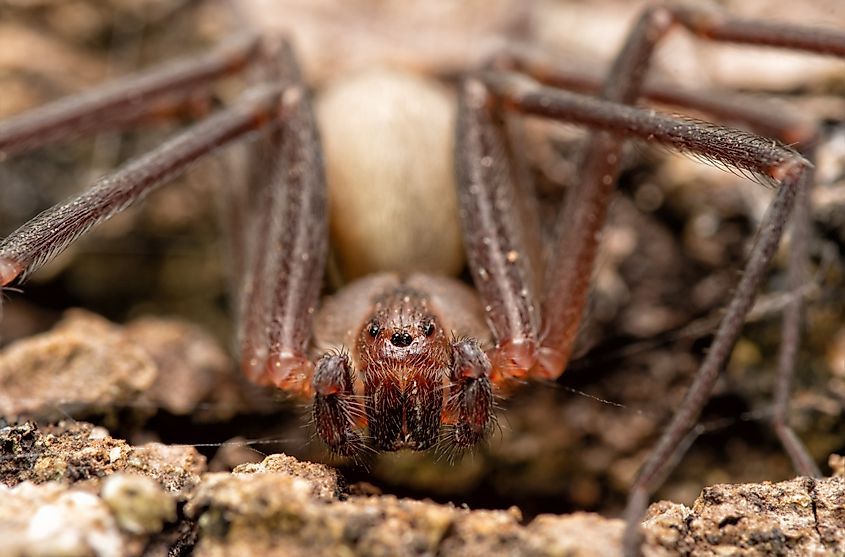
Another spider in the state, the Brown Recluse spider, is known for its necrotic venom, which can cause severe skin and tissue damage. This medium-sized spider exhibits a violin-shaped marking on its back and has six eyes arranged in three pairs. You mas find these spiders in warm, dry environments, especially human dwellings like attics, basements, closets, and behind furniture.
The Brown Recluse does not build webs to catch prey. Rather, they rely on their stealth and speed to ambush food such as small insects. The Recluse is true to its name and prefers to avoid humans and other animals. When threatened, they will typically flee rather than confront. But if they feel trapped, they may bite in self-defense.
If you are bitten, clean the area. Apply ice to minimize swelling and consult a healthcare professional, especially if symptoms worsen.
American Alligator
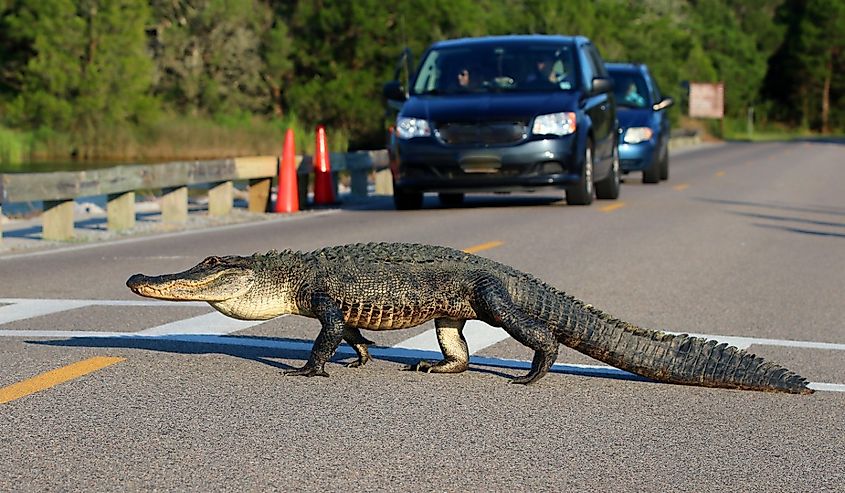
An iconic and awe-inspiring reptile, the American Alligator is known for its size and powerful bite. Weighing over 1,000 pounds, they range from 10 to 15 feet long, though some can grow even bigger. Their skin is covered with tough dark scales, lighter on their undersides. You can find these creatures in swamps, marshes, rivers, and other fresh bodies of water. They prefer slow-moving or still water with abundant vegetation and basking spots.
Alligators have powerful jaws lined with sharp teeth designed for gripping and tearing prey. They feed on fish, turtles, birds, mammals, and other reptiles while juvenile alligators eat smaller prey, such as insects, frogs, and small fish. As they grow, alligators can take down larger prey, such as deer and boar. They are ambush predators, waiting for the opportune time to capture unsuspecting prey and performing the iconic death roll to take them down.
Mostly nocturnal, alligators spend most of their time in water, patrolling their territory, or sunbathing. During the colder months, they enter a type of dormancy state in burrows or dens near the water. Alligators are territorial and can be aggressive, especially during mating season. Unlike many other reptiles, female alligators provide parental care to their offspring. They assist their hatchlings to water and spend several months defending them from predators.
Due to their size and strength, the American alligator is considered very dangerous. Though human attacks are rare, they can transpire when the animal feels threatened or provoked. Warning signs of an attack include bellowing or vocalization, hissing and jaw clapping, and approaching.
If you are approached by an alligator, try to get away. Move slowly, avoiding sudden movements that may provoke an attack. If they bite you, fight back, targeting the alligator’s eyes and snout. If bitten, seek medical attention immediately.
Seeing the American Alligator can amaze and frighten. While visiting the state, remember that feeding alligators is illegal and dangerous, as it can cause them to lose their natural fear of humans and become more aggressive. Keep a safe distance and respect the alligator’s habitat.
Bull Shark
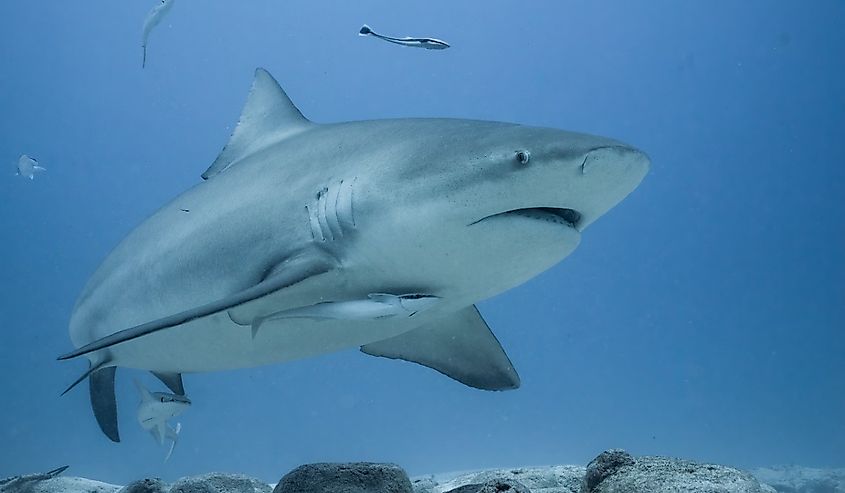
One of the most notorious sharks, the Bull Shark is known for its unique ability to thrive in both salt and freshwater. Large and stout-bodied, these sharks have an iconic rounded, blunt snout. They weigh up to 500 pounds and measure between 7 to 11 feet long. Their coloration is pale to dark grey with white undersides, providing camouflage in the water.
Bull Sharks are found in warm coastal waters, near shorelines, estuaries, and river mouths. They are often seen in shallow waters with depths of less than 100 feet. Opportunistic predators, they feed on fish, turtles, birds, and even dolphins. They are known for their aggressive hunting tactics, ramming their prey before delivering a fatal bite. This diverse diet and willingness to consume make them highly adaptable predators.
These sharks are aggressive and territorial. They are solitary creatures, though may occasionally be found hunting in groups. Unlike other sharks, they do not have a complex social system. Alongside the Great White and Tiger Shark, the Bull shark is one of the most commonly implicated in unprovoked attacks on humans. If you are enjoying a swim in one of South Carolina’s many bodies of water, keep in mind these Bull Shark warning signs.
Bull Sharks swimming erratically, such as jerky swimming behavior, or showing increased agitation may be more likely to attack. In addition, a Bull Shark arching their back with rapid side-to-side movements is showing an aggressive posture.
Move away slowly if you come face-to-face with a bull shark. If possible, get out of the water as quickly and calmly as possible. If you are attacked, defend yourself, aiming for the shark’s eyes and gills. Use any available object to fight back. If bitten, seek medical attention as soon as possible.
Portuguese Man o' War
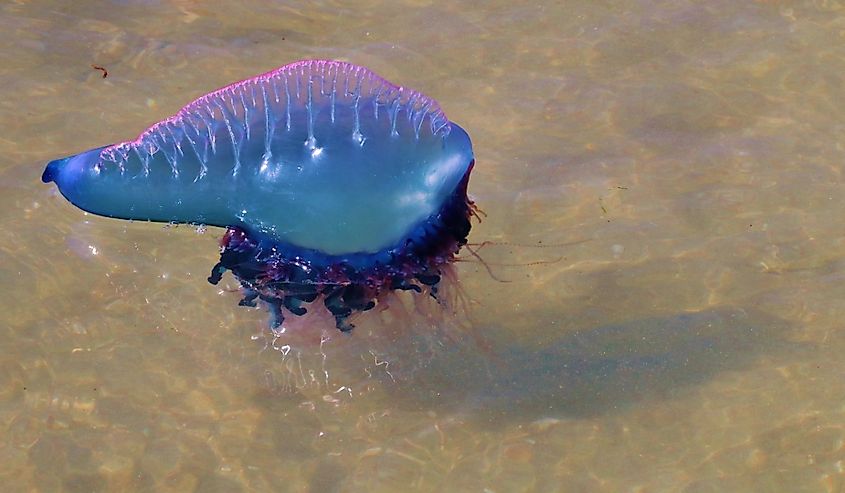
Often mistaken for a jellyfish, this siphonophore is a colonial organism made up of specialized, interdependent polyps. The Portuguese Man o’ War is a vibrant, blue, pink, or purple ballon-like creature, growing up to 12 inches long. Below its ballon-like structure, tentacles trail, extending up to 30 feet. These tentacles are equipped with specialized cells called nematocysts, which contain venom.
The Portuguese Man o’ War can be found in warm, tropical, and subtropical ocean waters. They are carnivores, primarily feeding on small fish, plankton, and other marine invertebrates. They ensnare their prey in their tentacles, using the venom to paralyze it. Once the prey is trapped, it is transferred to another part of the animal where it is broken down and absorbed.
This creature is a passive drifter, relying on ocean currents and wind to move through the water. It cannot swim and has no means of propulsion other than its gas-filled, ballon-like structure, acting like a sail. Being a siphonophore, this creature is composed of a colony of polyps, working together as a single organism. Each polyp has a distinguishing role, capturing prey, digesting prey, or reproducing. This unique organization allows the Portuguese Man o' War to function as a cohesive unit, with each polyp contributing to the survival of the colony.
The venom of their tentacles is formidable, delivering painful stings. A sting from the Portuguese Man o’ War can cause welts, fever, and severe pain. Though there are no clear warning signs, if you see this creature floating through the water or its long, blue tentacles, a sting can occur.
If you are stung, do not scrub the area. Rinse it with seawater, as fresh water can cause more venom to be released. Remove any remaining tentacles from the skin and apply vinegar to neutralize the venom. If symptoms are severe, seek medical attention.
Keep in mind, if you see one, there are likely more around. Never try handling this creature, even if they are washed up on the shore.
Ticks
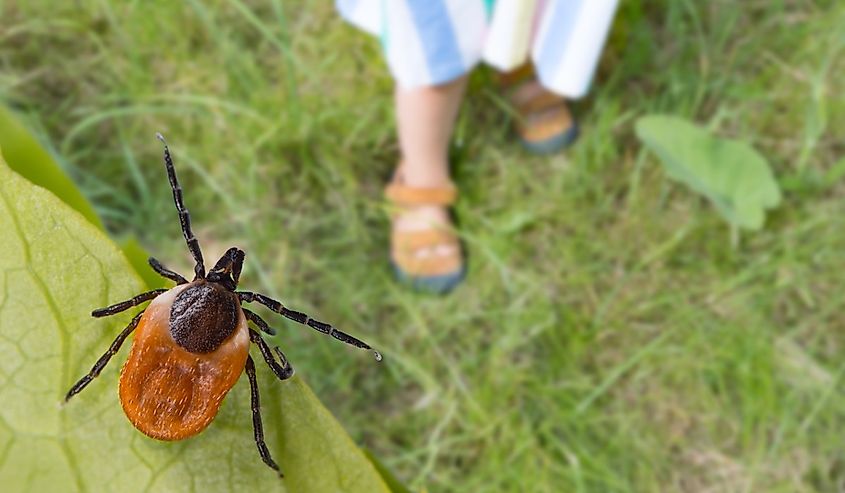
More than just a tiny nuisance, ticks are an infamous disease-carrying parasite. Closely related to arachnids and mites, ticks are characterized by their oval-shaped, flattened bodies. They have eight legs and are typically brown, reddish-brown, or black, although their appearance can change when they are engorged with blood.
Ticks thrive in a variety of environments, such as dense forests and grassy fields. They prefer high humidity and dense vegetation, which is prevalent in areas abundant with wildlife. You may find these pests in leaf litter, tall grass, shrubs, and wooded areas.
These pests are blood feeders, relying on blood meals from hosts. They feed on mammals, birds, reptiles, amphibians, and humans. Ticks are opportunistic feeders, attaching to any suitable host that passes by. They use their specialized mouthparts to pierce the skin and remain attached for several days, engorging themselves on the host's blood.
Ticks use a method called questing to find their hosts. When questing, they will climb to the tips of grasses or shrubs and extend their front legs, waiting to latch on a host that may pass by. Ticks are sensitive to carbon dioxide, heat, and movement, helping them detect potential hosts. Once attached, ticks can remain undetected due to their small size.
Ticks are dangerous because they can carry many diseases such as Lyme disease, Rocky Mountain Spotted Fever, Ehrlichiosis, Anaplasmosis, Babesiosis, and more.
After enjoying the beautiful wilderness South Carolina offers, check yourself thoroughly for ticks. Check clothing and pets, and check tick-popular areas such as the groin and underarms. If you find a tick, remove it promptly. Use fine-tipped tweezers to grasp the tick as close to the skin's surface as possible. Pull upward with even pressure to remove the tick without crushing it. Clean the area with soap and water or rubbing alcohol.
Small yet formidable, take preventative measures when enjoying your time outdoors in South Carolina. Wear long pants and high socks, and check yourself thoroughly when you return inside. Awareness and vigilance are key to avoiding these creatures.
Mosquitoes
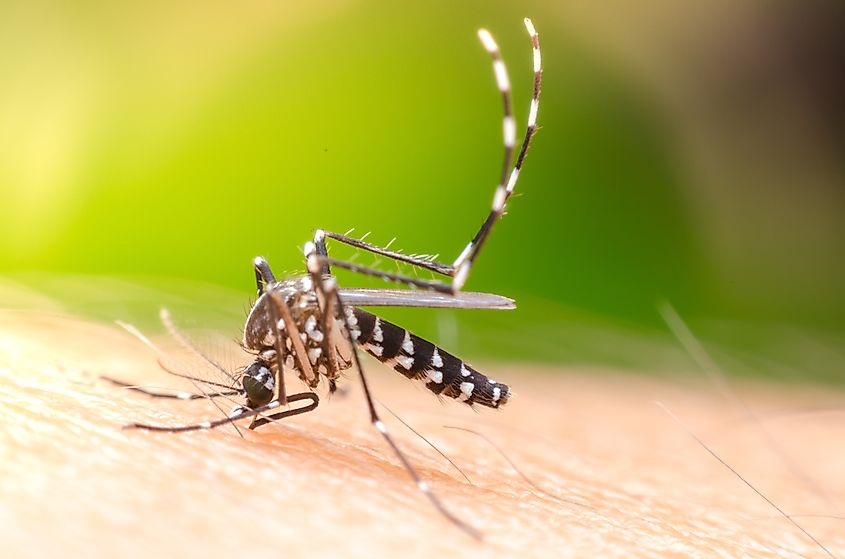
One of the most dangerous animals in the world, the mosquito poses a significant health risk as a vector for disease. These flying insects have slender bodies and long legs. They are recognizable by their elongated proboscis, which they use to pierce the skin. These creatures are found everywhere in the world, except Antarctica. They are more common during the warmer months, found near ponds, marshes, fields, and forests.
Mosquitos feed on nectar and plant juice, with only female mosquitoes dining on blood to nourish their eggs. Female mosquitoes are attracted to carbon dioxide, body heat, and other chemical cues emitted by hosts. They also have specialized sensory organs to detect heat and moisture, aiding them in locating suitable hosts. Most active during dawn and dusk, they feed on mammals, birds, reptiles, and amphibians.
Mosquitos can carry and transmit a wide range of diseases such as malaria, dengue fever, Zika virus, yellow fever, and West Nile virus. Avoid visible swarms of mosquitos and be aware of buzzing sounds they may exhibit. If you are bitten clean the area with soap and water and use an anti-itch cream if necessary. To reduce swelling use a cold compress and avoid scratching the area. Take preventative measures by wearing long sleeves, long pants, and high socks. Try insect repellent and avoid or eliminate standing water.
With its pristine natural beauty, South Carolina hosts biodiversity and diverse ecosystems. Spot a variety of wildlife such as beavers, minks, and over 300 species of birds. While not all of its inhabitants are dangerous, there are certainly some to look out for. As you dive into Myrtle Beach or Hilton Head Island, be vigilant of the bull shark and the vibrant Portuguese Man o’ War. After a hike through Rainbow Falls or Table Rock Mountain, check for ticks and mosquito bites, treating them promptly. While enjoying this state, be watchful and attentive for the deadliest animals. Remember, the beauty of South Carolina lies not only in its landscapes but also in the incredible wildlife that calls it home.











